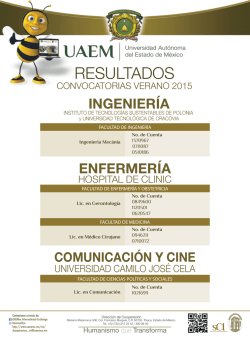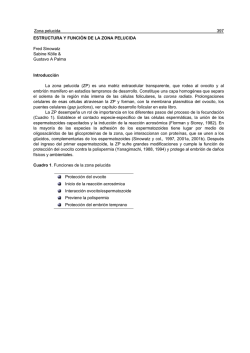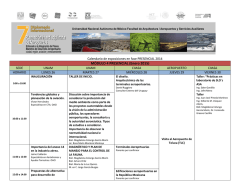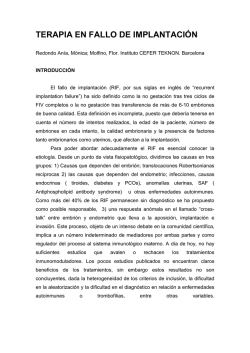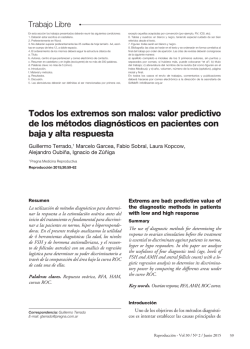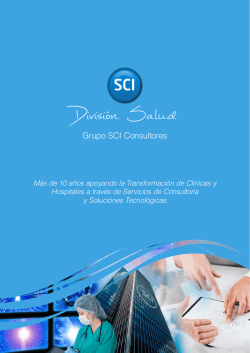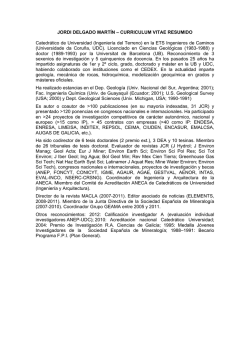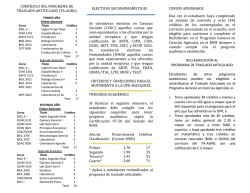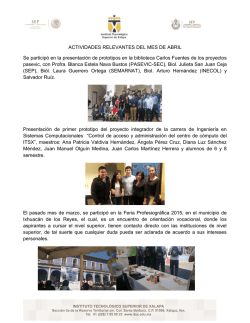
Biología de la reproducción 43 BIOLOGÍA DE LA
Biología de la reproducción 43 BIOLOGÍA DE LA REPRODUCCIÓN Gustavo A Palma Introducción La capacidad reproductiva es, obviamente, la condición indispensable de toda especie para preservarse. En producción animal tiene un significado central, dado que la cría de animales de interés productivo basa su existencia comercial en la fertilidad, la reproducción periódica y sistemática de los individuos. En otras palabras, reproducción eficiente. Por otra parte la reproducción sexual confiere a los organismos el beneficio evolutivo del proceso de recombinación genética, a diferencia de la reproducción asexuada, porque elimina las mutaciones deletéreas de la población, según la hipótesis de la epistasis sinérgica o reductora de la carga mutacional. Esto es, elimina a aquellos genotipos con mutaciones múltiples que tengan menos adecuación (epistasis negativa), como también permite incorporar características deseadas. A fin de comprender mejor las particularidades reproductivas de la mayoría de las especies domésticas y la humana, las posibilidades biotecnológicas, sus limitaciones y las alteraciones patológicas que tienen lugar, es importante considerar la dinámica biológica poblacional, como estrategia evolutiva, antes que fuera condicionada por el hombre y el comportamiento social humano. El crecimiento y tamaño de una población está determinado por 2 factores de interés biológico: La natalidad (tasa de nacimientos) La mortalidad (tasa de muertes) De esta manera la tasa de crecimiento de una población estará determinada por los nacimientos (b) en relación con las muertes (d): r = (b - d), dónde r = la proporción de crecimiento de población, b = la proporción del nacimiento y d = la mortalidad. Los factores que controlan a la población caracterizan ese potencial biótico, a través de: La capacidad de reproducirse (factores intrínsecos) y la interacción (o resistencia) al ambiente (factores extrínsecos) El crecimiento de la población dependerá de los animales presentes, de la tasa (r, de growth rate) y la capacidad máxima de crecimiento (k, de carring capacity). Esos son los puntos de partida de la biología reproductiva de las poblaciones llamadas k y n, o también conocidos como selección k y selección n, Fig 1. Las poblaciones n están constituidas por aquellos individuos de alto potencial biótico porque que viven en ambientes muy inestables. Con tamaño poblacional fluctuante, sufren grandes oscilaciones de la población, incluso hasta la eliminación de varias generaciones, aunque también pueden reproducirse con la misma rapidez. Están ampliamente distribuidos y sacan provecho rápidamente de las buenas oportunidades ambientales, pudiendo así, reestablecer la población inicial, lo que los caracteriza de oportunistas. Algunos ejemplos de las poblaciones n son: las bacterias, los insectos, los peces, el plancton y los roedores. Por el contrario, la estrategia k de reproducción corresponde a aquellos individuos que viven en equilibrio con un ambiente propicio, el cual les ofrece las condiciones óptimas para una vida longeva. Con un ambiente que asegura a los individuos tantos o más recursos de los que pueden consumir, tienen un tamaño poblacional estable y responden lentamente a las oportunidades ambientales (cuadro 1). Todas las especies animales de interés productivo y la humana pertenecen a la población k. La estrategia biológica de la población k establece que la capacidad reproductiva de un individuo no es una función prioritaria y por lo tanto todo lo que atente contra su bienestar, atentará también contra la reproducción. 44 Palma Crecimiento poblacional Nr. de individuos k r Tiempo en meses Fig 1. Poblaciones animales según sus particularidades reproductivas Esta estrategia podría brindar una hipótesis biológica para explicar determinados fenómenos del comportamiento social humano de porqué, por ejemplo, las sociedades de algunos países industrializados con las mejores condiciones de vida, tienen la mayor longevidad, las menores tasas de mortalidad y una tasa reproductiva negativa. Esto es, la capacidad de la especie humana de reconocer su condición de bienestar y proyectarle sus deseos, fantasías y aspiraciones a su futuro, subordina su reproducción, disminuyéndola. Cuadro 1. Estrategias reproductivas de las poblaciones k Extenso tiempo de desarrollo embrionario Tardía edad de la pubertad Reproducción durante la mayor parte de su vida Extenso período de gestación Bajo número y alto cuidado de la cría de crías Suponiendo que esta hipótesis fuera aceptable, es posible intuir, entonces, que mientras una pareja alemana prefiere disfrutar de las buenas condiciones de vida que le ofrece su ambiente sin reproducirse, para evitar “competir” luego con su descendencia, un animal sometido a situaciones ambientales (productivas, reproductivas o biotecnológicas) que atenten contra su bienestar, disminuirá su eficiencia reproductiva. No es necesario que las condiciones ambientales pongan en peligro la vida del individuo para que disminuya significativamente la eficiencia reproductiva. El manejo y selección inadecuados de los reproductores que componen los rodeos lecheros, la aplicación errónea de las biotecnologías con tratamientos hormonales para la superovulación en programas de transferencia de embriones o la sobre-estimulación ovárica, en programas de la punción folicular para la producción in vitro de embriones, pueden provocar efectos adversos (ver capítulo superovulación y OPU). También permite comprender por qué los bovinos de razas europeas, que fueron exportados a países tropicales en la década del ‘70 no se reprodujeron como lo hacían bajo sus propias condiciones de origen. La característica de que respondan lentamente a las condiciones ambientales explicaría también porque no sirvieron las cámaras especialmente diseñadas en Alemania para adaptar, durante semanas, a toros antes de ser exportados al trópico. Lentamente puede significar en biología adaptativa numerosas generaciones. También explica las significativas diferencias en la eficiencia reproductiva de la especie bufalina, cuando es producida bajo mejores condiciones (ver capítulo biología de la reproducción de la hembra bufalina), como es el caso en Argentina y Brasil frente a India. Se conoce que la desnutrición afecta a la reproducción, no obstante, no es necesario que el animal esté desnutrido para que no ovule o lo haga sin presentar celo (celo silente), o éste sea corto. Biología de la reproducción 45 Eso explicaría por qué animales en buen estado pero carentes, por ejemplo de selenio en la dieta, tienen inferior producción de ovocitos y éstos de baja calidad. Cuando se enfoca la posible explicación fenomenológica, desde el punto de vista de la implacable estrategia poblacional k, muchos de los alcances limitados de la biotecnología de la reproducción deberían ser considerados como grandes éxitos. Actualmente las acciones médicas en la reproducción se concentran en las siguientes áreas: Comprensión de los fenómenos biológicos Estatus ginecológico (reconocimiento del ciclo estral) Estatus andrológico (evaluación de la calidad espermática) Interpretación del diagnóstico Diagnóstico y tratamiento de enfermedades Control del fenómeno reproductivo grupal con el fin de incrementar la eficiencia reproductiva (control reproductivo y fertilidad de los rodeos), como los tratamientos hormonales Control o asistencia individual para incrementar o establecer la capacidad reproductiva, como la reproducción asistida en las especies humana y animal, con fines terapéuticos y económicos (inseminación artificial intravaginal, intrauterina o intratubárica) producción in vitro de embriones, producción de mellizos idénticos, clonación a través de transferencia nuclear, etc. Control de la reproducción con fines anticonceptivos, para bloquear la eficiencia reproductiva femenina y masculina El objetivo del presente capítulo es presentar algunos fenómenos reproductivos que permitan interpretar más cabalmente las interacciones neuro-hormonales presentadas por Rivera y Callejas (ver libros rojo y azul en el CD), como también las consecuencias biológicas de la relación entre individuos, de éstos con el ambiente y el posible efecto de este último sobre la respuesta a los tratamientos biotecnológicos. Se presentará el rol de los esteroides en el desarrollo folicular, el control hormonal y vascular de la regresión luteal, las prostaglandinas intraluteales, el efecto de la nutrición y sus señales neuropeptídicas sobre la biología reproductiva. 46 Palma Bibliografía Acosta TJ, Yoshizawa N, Ohtani M and A Miyamoto (2002) Local changes in blood flow within the early and midcycle corpus luteum after prostaglandin F2α injection in the cow Biol Reprod 66, 651– 658 Ahima RS and JS Flier (2000) Adipose tissue as an endocrine organ Trends Endocrinol Metab 11, 327–332 Amstalden M, Garcia MR, Williams SW, Stanko RL, Nizielski SE, Morrison CD, Keisler DH, GL Williams (2000) Leptin gene expression, circulating leptin, and luteinizing hormone pulsatility are acutely responsive to short-term fasting in prepubertal heifers: Relationships to circulating insulin and insulin-like growth factor I Biol Reprod 63, 127-133 Asselin E, Goff AK, Bergeron H and MA (1996) Fortier Influence of sex steroids on the production of prostaglandins F2 and E2 and response to oxytocin in cultured epithelial and stromal cells of the bovine endometrium Biol Reprod 54, 371–379 Bah MM, Acosta TJ, Pilawski W, Deptula K, Okuda K, DJ Skarzynski (2006) Role of intraluteal prostaglandin F(2alpha), progesterone and oxytocin in basal and pulsatile progesterone release from developing bovine corpus luteum Prostaglandins Other Lipid Mediat 79, 218-29 Barb CR, Kraeling RR, Rampacek GB, Barnett JB (1999) Neuropeptide Y: a possible link between LH and GH in the gilt J Anim Sci 77, 223 Beach FA (1976) Sexual attractivity, proceptivity, and receptivity in female mammals Horm Behav 7, 105–138 Beata C (2001) Appeasing Pheromones in Mammals 26th WSAVA congress proceedings; Vancouver, British Columbia, Canada August 8-11 Belund H, Lindstom P and I Savic (2006) Brian reponse to putative pheromones in lesbian women PNAS 1003, 8269-8274 Bensafi M, Brown WM, Khan R, Levenson B and N Sobel (2004) Sniffing human sex-steroid derived compounds modulates mood, memory and autonomic nervous system function in specific behavioral contexts Behav Brain Res 152, 11-22 Bensafi M, Brown WM, Tsutsui T, Mainland JD, Johnson BN, Bremner EA, Young N, Mauss I, Ray B, Gross J, Richards J, Stappen I, Levenson RW and N Sobel (2003) Sex-Steroid Derived Compounds Induce Sex-Specific Effects on Autonomic Nervous System Function in Humans Behav Neurosci 117, 1125-1134 Boland MP, Lonergan lP and D O’Callaghanz (200l) Effect of nutrition on endocrine parameters, ovarian physiology, and oocyte and embryo development Theriogenology 55, 1323-1340 Brown JL and A Eklund (1994) Kin recognition and the major histocompatibility complex: an integrative review Am Nat 14, 435-461 Christiansen K, Behavioural correlates of testosterone In: E Nieschlag and HM Behre (Ed.), Testosterone. Action-deficiency-substitution (2nd ed.), Springer, Heidelberg (1998), 107–142 Claus R (1994): Pheromone. In: Döcke, F. (Ed.): Veterinärmedizinische Endokrinologie Gustav Fischer Verlag - Jena, Stuttgart, 691–712 Claus R, Over R, M Dehnard (1990) Effect of male odour on LH secretion and the induction of ovulation in seasonally anoestrous goats Anim Reprod Sci 22, 27–38 Cohen-Tanoudji J, Einhorn J, JP Signoret (1994) Ram sexual pheromone: first approach of chemical identification Physiol Behav 56, 955–961 Davis JS, Weakland LL, Weiland DA, Farese RV and LA West (1987) Prostaglandin F2α stimulates phosphatidylinositol 4,5-bisphosphate hydrolysis and mobilizes intracellular Ca2+ in bovine luteal cells. Proc Natl Acad Sci84, 3728–3732 Day ML and LH Anderson (1998) Current concepts on the control of puberty in cattle J Anim Sci 76, 1–15 Diskin MG, Mackey DR, Roche JF, JM Sreenan (2003) Effects of nutrition and metabolic status on circulating hormones and ovarian follicle development in cattle 78, 345-70 Diskin MG, Murphy JJ and JM Sreenan (2006) Embryo survival in dairy cows managed under pastoral conditions Anim Reprod Sci 96, 297-311 Biología de la reproducción 47 Drummond AE (2006) The role of steroids in follicular growth Reprod Biol Endocrinol 4, 16 Doving KB and D Trotier (1998) Struture and function of the vomeronasal organ J Exp Biol 201, 29132925 Elias CF, Lee C, Kelly J, Aschkenasi C, Ahima RS, Bjørbæk C, Flier JS, Saper CB, JK Elmquist (1999) Leptin differentially regulates NPY and POMC neurons projecting to the lateral hypothalamic area Neuron 23, 775-786 ESHRE Capri Workshop Group (2006) Nutrition and reproduction in women Hum Reprod Update 12, 193-207 Evans A and F Mulligan (2006) Nutrition and fertility in dairy cattle (In Press) Available online 3 August Fortune JE, Rivera GM, MY Yang (2004) Follicular development: the role of the follicular microenvironment in selection of the dominant follicle Anim Reprod Sci 82-83, 109-126 Fukushima N, Hanada R, Teranishi H, Fukue Y, Tachibana T, Ishikawa H, Takeda S, Takeuchi Y, Fukumoto S, Kangawa K, Nagata K, M Kojima (2005) Ghrelin directly regulates bone formation. Bone Miner Res 20, 790–798 Gazal OS, Leshin LS, Stanko RL, Thomas MG, Keisler DH, Anderson LL, GL Williams (1998) Gonadotropin-releasing hormone secretion into third-ventricle cerebrospinal fluid of cattle: correspondence with the tonic and surge release of luteinizing hormone and its tonic inhibition by suckling and neuropeptide Y Biol Reprod 59, 676–683 Gnanapavan S, Kola B, Bustin SA, Morris DG, McGee P, Fairclough P, Bhattacharya S, Carpenter R, Grossman AB and M Korbonits (2002) The tissue distribution of the mRNA of ghrelin and subtypes of its receptor, GHS-R, in humans J Clin Endocrinol Metab 87, 2988–2991 Gelez H and C Fabre-Nys (2004) The "male effect" in sheep and goats: a review of the respective roles of the two olfactory systems Horm Behav 46, 257-271 Gelez H, Archer E, Chesneau D, Campan R, C Fabre-Nys (2004) Importance of learning in the response of ewes to male odor Chem Senses 29, 555–563 Gelez H, C Fabre-Nys (2006) Role of the olfactory systems and importance of learning in the ewes' response to rams or their odors Reprod Nutr Dev 46, 401-415 Goff AK (2004) Steroid hormone modulation of prostaglandin secretion in the ruminant endometrium during the estrous cycle Biol Reprod 71, 11-16 Gong JG (2002) Influence of metabolic hormones and nutrition on ovarian follicle development in cattle: practical implications Dom Anim Endocrinol 23, 229–241 Grammer K, Fink B, N Neave (2005) Human pheromones and sexual attraction Eur J Obs Gyn Reprod Biol 118, 135-152 Hampton JH, Manikkam M, Lubahn DB, Smith MF and HA Garverick (2004) Androgen receptor mRNA expression in the bovine ovary Domest Anim Endocrinol 27, 81-88 Hayashi S and T Kimura (1974) Sex-attractant emitted by female mice Physiol Behav 13, 563–567. Hayashi K, Acosta TJ, Berisha B, Kobayashi S, Ohtani M, Schams D and A Miyamoto (2003) Changes in prostaglandin secretion by the regressing bovine corpus luteum Prostaglandins Other Lipid Mediat; 70, 339–349 Henson MC and VD.Castracane (2006) Leptin in pregnancy: an update Biol Reprod 74, :218-229 Horie K, Takakura K, Fujiwara H, Suginami H, Liao S and T Mori (1992) Immunohistochemical localisation of androgen receptor in the human ovary throughout the menstrual cycle in relation to oestrogen and progesterone receptor expression Hum Reprod 7, 184-190. Hurst JL, Payne CE, Nevison CM, Marie A D, Humphries RE, Robertson DHL, Cavaggioni A and RJ Beynon (2001) Individual recognition in mice mediated by major urinary proteins Nature 414, 631634 Iqbal J, Kurose Y, Canny B, IJ Clarke (2006) Effects of central infusion of ghrelin on food intake and plasma levels of growth hormone, luteinising hormone, prolactin, and cortisol secretion in sheep Endocrinology 147, 510–519 Iwata E, Kikusui T, Takeuchi Y, Mori Y (2003) Substances derived from 4-ethyl octanoic acid account for primer pheromone activity for the "male effect" in goats J Vet Med Sci 65, 1019-10121 Izard MK and JG Vandenbergh (1982) The effects of bull urine on puberty and calving date in crossbred beef heifers J Animal Sci 55, 1160–1168 48 Palma Jacob S and MK McClintock (2000) Psychological state and mood effects of steroidal chemosignals in women and men Horm Behav 37, 57-78 Jacob S, Hayreh DJ and MK McClintock (2001) Context-dependent effects of steroid chemosignals on human physiology and mood Physiol Behav 74, 15-27 Jacob S, McClintock MK, Zelano B and V Ober (2002) Paternally inherited HLA alleles are associated with women's choice of male odor. Nat Genet 30, 175-179 Jamnongjit M and SR Hammes (2006) Ovarian steroids: the good, the bad, and the signals that raise them Cell Cycle 5, 1178-1183 Jordan WC and MW Bruford (1998) New perspectives on mate choice and the MHC Heredity 81, 239245 Karlson P and M Lüscher (1959) “Pheromones”: a new term for a class of biologically active substances Nature 183, 55–56 Katongole CB, Naftolin F and RV Short (1971) Relationship between blood levels of luteinizing hormone, and testosterone in bulls and the effect of sexual stimulation J Endocrinol 50, 457–466 Kawamura K, Sato N, Fukuda J, Kodama H, Kumegai J, Tanikawa H, Nakamura A, Honda Y, Sato T, T Tanaka (2003) Ghrelin inhibits the development of mouse preimplantation embryos in vitro Endocrinology 144, 2623–2633 Kershaw EE and JS Flier (2004) Adipose tissue as an endocrine organ J Clin Endocrinol Metab 89, 2548–2556 Kindahl H, Lindell JO and LE Edqvist (1981) Release of prostaglandin F2 during the oestrous cycle Acta Vet Scand 77, 143–158 Kojima M, Hosoda H, Date Y, Nakazato M, Matsuo H and K Kangawa (1999) Ghrelin is a growthhormone-releasing acylated peptide from stomach Nature 402, 656-660 Korbonits M, Goldstone AP, Gueorguiev M and AB Grossman (2004) Ghrelin a hormone with multiple functions Frontiers in Neuroendocrinology 25, 27-68 Kumar KR, Archunan G, Jeyaraman R and S Narasimhan (2000) Chemical characterization of bovine urine with special reference to oestrus Vet Res Comm 24, 445-454 Liberles SD and LB Buck (2006) A second class of chemosensory receptors in the olfactory epithelium Nature 442, 645-650 Lucy MC (2000) Regulation of ovarian follicular growth by somatotropins and insulin-like growth factors in cattle J Dairy Sci 83, 1635–1647 Lucy MC (2003) Mechanisms linking nutrition and reproduction in postpartum cows Reproduction in Domestic Ruminants V Reproduction Suppl 61, 415–417 Lundström JN (2005) Psychological and Neurological modulation of a putative human pheromone Acta Universitatis Upsaliensis Faculty of social Sciencies, Uppsala, 1-73 Maier ChM (2005) Wirkung eines synthetisch hergestellten Pheromon-analogs (PAP) auf das Wohlbefinden von Mastschweinen beim Transport zum Schlachthof, Dissertation, München, 3-10 Matchock RL and EJ Susman (2006) Family Composition and Menarcheal Age: Anti-Inbreeding Strategies Am J Hum Biol 18, 481–491 McGlone JJ and DL Anderson (2002) Synthetic maternal pheromone stimulates feeding behavior and weight gain in weaned pigs J Anim Sci 80, 3179-3183 Schams D and B Berisha (2004) Regulation of corpus luteum function in cattle-an overview Reprod Dom Anim 39, 241–251. Meidan R, Levy N, Kisliouk T, Podlovny L, Rusiansky M, E Klipper (2005) The yin and yang of corpus luteum-derived endothelial cells: balancing life and death Domestic Anim Reprod29, 318–328. Meredith M (2001) Human vomeronasal organ function: a critical review of best and worst cases Chem Senses 26, 433– 445 Morrison CD, Daniel JA, Buff PR, DH Keisler (1999) Continuous, intracerebroventricular infusion of neuropeptide Y induces a prolonged suppression of LH J Anim Sci 77, 216 Mulac-Jericevic B, Mullinax RA, DeMayo FJ, Lydon JP and OM Conneely (2000) Subgroup of reproductive functions of progesterone mediated by progesterone receptor-B isoform Science 289, 1751-1754 Biología de la reproducción 49 Mulac-Jericevic B, Lydon JP, DeMayo FJ and OM Conneely (2003) Defective mammary gland morphogenesis in mice lacking the progesterone receptor B isoform Proc Natl Acad Sci, 100, 97449749 Myers MG Jr (2004) Leptin receptor signaling and the regulation of mammalian physiology Recent Prog Horm Res 59, 287-304 Nakahara K, Nakagawa M, Baba Y, Sato M, Toshinai K, Date Y, Nakazato M, Kojima M, Miyazato M, Kaiya H, Hosoda H, Kangawa K, N Murakami () Maternal ghrelin plays an important role in rat fetal development during pregnancy Endocrinology 147, 1333-1342 Nelson RJ and S Chiavegatto (2001) Molecular basis of aggression Trends Neurosci 24, 713–19 Over R, Cohen-Tannoudji J, Claus M and JP Signoret (1990) Effect of pheromones from male goats on LH secretion in anestrous ewes Physiol Behav 48, 665–668 Pearson Helen (2006) Early embryos can yield stem cells... and survive Nature 442, 858 Penny LA, Armstrong DG, Bramley T,Weeb R, Collins RA,Watson ED (1999) Immune cells and cytokine production in the bovine corpus luteum throughout the estrous cycle and after induced luteolysis J Reprod Fertil 115, 87–96 Penton-Voak IS, Jones BC, Little AC, Baker S, Tiddeman B, Burt DM and DI Perrett (2001) Symmetry, sexual dimorphism in facial proportions and male facial attractiveness Proc R Soc Lond B Biol Sci 268, 1617-1623 Petri G, Wysocki CJ, Barhart KT, Sondheimer SJ, JJ Leiden (2003) Male axilar extracts contain pheromones that effect pulsatile secretion of luteinizing hormone and mood in women recipients Horm Behav 20, 474-482 Petroff MG, Petroff BK, JL Pate (2001) Mechanisms of cytokine-induced death of cultured bovine luteal cells Reproduction 121, 753–760 Rekwot PI, Ogwu D, Oyedipe EO and VO Sekoni (2001) The role of pheromones and biostimulation in animal reproduction Anim Reprod Scie 65, 157-170 Rasmussen LE and DR Greenwood (2003) Frontalin: a chemical message of musth in Asian elephants (Elephas maximus) Chem Senses 28, 433-46 Rekwot PI, Ogwu D, Oyedipe EO and VO Sekoni (2000a) Effects of bull exposure and body growth on onset of puberty in Bunaji and Friesian x Bunaji heifers Reprod Nutr Dev 40, 1–9 Rekwot PI, Ogwu D, EO Oyedipe (2000b) The influence of bull biostimulation, season and parity on resumption of ovarian activity of Zebu (Bos indicus) cattle following parturition Animal Reprod Sci 63, 1–11 Rekwot PI, Ogwu D, Oyedipe EO and VO Sekoni (2001) The role of pheromones and biostimulation in animal reproduction Anim Reprod Sci65, 157-70 Roberson MS, Wolfe MW, Stumpf TT, Werth LA, Cupp AS, Kojima ND, Wolfe PL, Kittok RJ, JE Kinder (1991) Influence of growth rate and exposure to bulls on age at puberty in beef heifers J Animal Sci 69, 292–298 Rosa HJD, Juniper DT and MJ Bryant (2000) The effect of exposure to oestrus ewes on rams sexual behaviour, plasma testosterone concentrations and ability to stimulate ovulation in seasonally anoestrus ewes Appl Anim Behav Sci 67, 293-305 Rushton JP and TA Bons (2005) Mate choice and friendship in twins: evidence for genetic similarity Psychol Sci 16: 555–559 Salcedo R, Ponce ML, Young HA, Wasserman K, Ward JM, Kleinman HK, Oppenheim JJ, Murphy WJ (2000) Human endothelial cells express CCR2 and respond to MCP-1: direct role of MCP-1 in angiogenesis and tumor progression Blood 96, 34-40 Sambrus, 1971 citado por Weitze K-F (2001) Andrologie beim Bullen En: Bush W, A Holzmann (Ed.), Physiologie und Pathologie der Fortpflanzung bei männlichen Tieren, Schattauer Verlag, Stuttgart, New York, 119-216 Shearer MK, LS Katz (2006) Female-female mounting among goats stimulates sexual performance in males Hor Beh 50, 33-37 Skarzynski DJ, Jaroszewski JJ, K Okuda (2005) Role of tumor necrosis factor-alpha and nitric oxide in luteolysis in cattle Domest Anim Endocrinol 29, 340-346 50 Palma Slomczynska M, Duda M and K Slzak (2001) The expression of androgen receptor, cytochrome P450 aromatase and FSH receptor mRNA in the porcine ovary Folia Histochem Cytobiol 39, 9-13 Smith OB and B Somande (1994) Interaction between nutrition and reproduction in farm animals Proceedings of a regional seminar held by the International Foundation for Science, Niamey, Niger, January 17-21, 7-26 Spencer AG, Woods JW, Arakawa T, Singer II and WL Smith (1998) Subcellular localization of prostaglandin endoperoxide H synthases-1 and -2 by immunoelectron microscopy J Biol Chem 273, 9886–9893 Steckler T, Wang J, Bartol FF, Roy SK and V Padmanabhan (2005) Fetal programming: prenatal testosterone treatment causes intrauterine growth retardation, reduces ovarian reserve and increases ovarian follicular recruitment Endocrinology 146, 3185-3193 Stern K and MK McClintock (1998) Regulation of ovulation by human pheromones Nature 392, 177179 Tarin JJ and V Gomez-Piquer (2002) Do women have a hidden heat period? Hum Reprod 17, 22432248 Towson DH, O’Connor CL, JK Pru (2002) Expression of Monocyte Chemoattractant Protein-1 and Distribution of Immune Cell Populations in the Bovine Corpus Luteum Throughout the Estrous Cycle Biol Reprod 66, 361–366 Vandenbergh JG Acceleration and inhibition of puberty in female mice by pheromones J Reprod Fertil Suppl 19, 411-419 Vulliemoz NR, Xiao E, Xia-Zhang L, Germond M, Rivier J, M Ferin (2004) Decrease in luteinizing hormone pulse frequency during a five-hour peripheral ghrelin infusion in the ovariectomized rhesus monkey J Clin Endocrinol Metab 89, 5718-5723 Wade GN and JE Jones (2004) Neuroendocrinology of nutritional infertility Am J Physiol Regul Integr Comp Physiol 287, R1277-1296 Walkden-Brown SW, Restall H, H Henniawati (1993) The male effect in the Australian cashmere goat: 1. Ovarian and behavioural response of seasonally anovulatory does following the introduction of bucks Anim Reprod Sci 32, 41–53 Wauters M, Considine RV and van LF Gaal (2000) Human leptin: from an adipocyte hormone to an endocrine mediator Eur J Endocrinol 143, 293–311 Webb R, Garnworthy PC, Gong J-G and DG Armstrong (2004) Control of follicular growth: local interactions and nutritional influences J Anim Sci 82, E63-E74 Wedekind C, Seebeck T, Bettens F, AJ Paepke (1995) MHC-dependent mate preferences in humans Proc R Soc Lond B 260, 245-249 Weitze K-F (2001) Andrologie beim Bullen En: Bush W, A Holzmann (Ed.), Physiologie und Pathologie der Fortpflanzung bei männlichen Tieren, Schattauer Verlag, Stuttgart, New York, 119-216 Whitten WK (1959) Occurrence of anoestrus in mice caged in groups J Endocrinol 18, 102–107 Wilson OE and WH Bossert (1963) Chemical communication among animals Recent Progr Hormone Res 19, 673–716 Wiltbank MC and JS Ottobre (2003) Regulation of intraluteal production of prostaglandins Reprod Biol Endocrinol 10 1:91 Wyatt TD (2004) Pheromones and animal behaviour In: Communication by smell and taste, Cambridge University Press, pp 391 Wysocki JCh and G Preti (2004) Facts, fallacies, fears and frustrations with human pheromones Anat Rec Part A 281A, 1201-1211 Xiao C, Liu JM, Sirois J, AK Goff (1998) Regulation of cyclooxygenase-2 and prostaglandin F synthase gene expression by steroid hormones and interferon-t in bovine uterine endometrial cells Endocrinology 139, 2293–2299 Yoon H, Enquist LW and C Dulac (2005) Olfactory inputs to hypothalamic neurons controlling reproduction and fertility Cell 123, 669-682 Zeng X-nong, Leyden JJ, Lawley HJ, Sawano K, Nohara I and G Preti Analysis of characteristic odours from human male axillae J Chem Ecol 17, 1469-1492
© Copyright 2025
